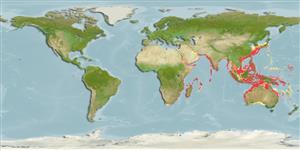>
Carangiformes (Jacks) >
Carangidae (Jacks and pompanos) > Caranginae
Etymology: Decapterus: Greek, deka = ten + Greek, pteron = wing, fin (Ref. 45335).
More on author: Rüppell.
Environment: milieu / climate zone / depth range / distribution range
Sinh thái học
Biển Sống nổi và đáy; Mức độ sâu 40 - 275 m (Ref. 12260). Tropical; 40°N - 36°S, 18°E - 172°E
Indo-West Pacific: East Africa to Japan, the Arafura Sea (Ref. 9819) and Australia. A Lessepsian migrant (Ref. 72453).
Length at first maturity / Bộ gần gũi / Khối lượng (Trọng lượng) / Age
Maturity: Lm 16.1, range 14 - 24.5 cm
Max length : 45.0 cm TL con đực/không giới tính; (Ref. 9987); common length : 30.0 cm TL con đực/không giới tính; (Ref. 9987); Khối lượng cực đại được công bố: 110.00 g (Ref. 4883); Tuổi cực đại được báo cáo: 12 các năm (Ref. 5406)
Các tia vây lưng cứng (tổng cộng) : 9; Các vây lưng mềm (tổng cộng) : 28 - 31; Tia cứng vây hậu môn: 3; Tia mềm vây hậu môn: 25 - 28; Động vật có xương sống: 24. Lateral line curved below soft dorsal and with 30-44 strong scutes; color bluish green above, silvery below; caudal fin hyaline to yellowish; dorsal fins hyaline basally, light dusky distally. Opercle with small, black spot; opercular membrane with smooth margin. Snout longer than eye diameter; squarish lower posterior edge of maxilla; upper jaw with small teeth anteriorly; soft dorsal and anal fins relatively low, not falcate; pectoral fin sub falcate. (Other source of data on morphology: Refs. 3131, 3197, 3287).
Adults dwell from middle to benthic (Ref. 11230), forming large schools in deep water, but occasionally inshore in sheltered bays in small to large groups (Ref. 48635). The most common Decapterus in coastal waters and on open banks of the Indian Ocean. They feed mainly on smaller planktonic invertebrates. Generally marketed fresh, may be dried or salted. Also sold frozen and canned (Ref. 9987).
Paxton, J.R., D.F. Hoese, G.R. Allen and J.E. Hanley, 1989. Pisces. Petromyzontidae to Carangidae. Zoological Catalogue of Australia, Vol. 7. Australian Government Publishing Service, Canberra, 665 p. (Ref. 7300)
IUCN Red List Status (Ref. 130435)
Threat to humans
Harmless
Human uses
Các nghề cá: tính thương mại cao; mồi: occasionally
Các công cụ
Special reports
Download XML
Các nguồn internet
Estimates based on models
Preferred temperature (Ref.
123201): 16.8 - 27.4, mean 23.2 °C (based on 690 cells).
Phylogenetic diversity index (Ref.
82804): PD
50 = 0.5010 [Uniqueness, from 0.5 = low to 2.0 = high].
Bayesian length-weight: a=0.01047 (0.00917 - 0.01196), b=2.96 (2.93 - 2.99), in cm total length, based on LWR estimates for this species (Ref.
93245).
Mức dinh dưỡng (Ref.
69278): 3.7 ±0.4 se; based on diet studies.
Generation time: 1.5 (1.2 - 1.7) years. Estimated as median ln(3)/K based on 28
growth studies.
Thích nghi nhanh (Ref.
120179): Trung bình, thời gian nhân đôi của chủng quần tối thiểu là 1.4 - 4.4 năm (K=0.2-1.4; tm=3; Fec=20,000; tmax>3).
Prior r = 0.68, 95% CL = 0.45 - 1.03, Based on 16 data-limited stock assessments.
Fishing Vulnerability (Ref.
59153): Low vulnerability (24 of 100).
Climate Vulnerability (Ref.
125649): Moderate vulnerability (42 of 100).
Nutrients (Ref.
124155): Calcium = 394 [150, 1,297] mg/100g; Iron = 3.4 [1.2, 8.1] mg/100g; Protein = 19.4 [18.0, 20.9] %; Omega3 = 0.359 [0.161, 0.825] g/100g; Selenium = 148 [46, 441] μg/100g; VitaminA = 10.8 [2.3, 46.9] μg/100g; Zinc = 1.31 [0.73, 2.52] mg/100g (wet weight); based on
nutrient studies.
